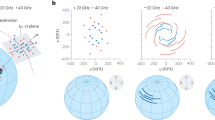
Overview
- Presents the 6th edition of a leading textbook on radio astronomy to include state-of-the-art descriptions of instrumentation and new observations
- Provides reworked derivations of equations and updates which reflect advances in technology and data reduction algorithms
- Includes treatments of the wider bandwidths in use on by modern radio, mm and sub-mm arrays
- Includes supplementary material: sn.pub/extras
Part of the book series: Astronomy and Astrophysics Library (AAL)
Access this book
Tax calculation will be finalised at checkout
Other ways to access
About this book
This 6th edition of “Tools of Radio Astronomy”, the most used introductory text in radio astronomy, has been revised to reflect the current state of this important branch of astronomy. This includes the use of satellites, low radio frequencies, the millimeter/sub-mm universe, the Cosmic Microwave Background and the increased importance of mm/sub-mm dust emission.
Several derivations and presentations of technical aspects of radio astronomy and receivers, such as receiver noise, the Hertz dipole and beam forming have been updated, expanded, re-worked or complemented by alternative derivations. These reflect advances in technology.
The wider bandwidths of the Jansky-VLA and long wave arrays such as LOFAR and mm/sub-mm arrays such as ALMA required an expansion of the discussion of interferometers and aperture synthesis. Developments in data reduction algorithms have been included.
As a result of the large amount of data collected in the past 20 years, the discussion of solar system radio astronomy, dust emission, and radio supernovae has been revisited.
The chapters on spectral line emission have been updated to cover measurements of the neutral hydrogen radiation from the early universe as well as measurements with new facilities. Similarly the discussion of molecules in interstellar space has been expanded to include the molecular and dust emission from protostars and very cold regions.
Several worked examples have been added in the areas of fundamental physics, such as pulsars.
Both students and practicing astronomers will appreciate this new up-to-date edition of Tools of Radio Astronomy.
Similar content being viewed by others
Keywords
Table of contents (16 chapters)
-
Front Matter
-
Back Matter
Reviews
Aus den Rezensionen zur 6.Auflage:
“... Studenten und Absolventen einschlägiger Fachrichtungen ist das Buch auch fur Quereinsteiger und Amateure geeignet, die ernsthaft in dieses Fachgebiet eindringen wollen.“ (in: Funkamateur, Heft 5, 2014)
Authors and Affiliations
About the authors
Kristen Rohlfs studied Astronomy and Physics and received a PhD in 1961 in Hamburg. After his postdoctoral lecture qualification in 1965 he worked at the Max-Planck-Institute for Radioastronomy in Bonn. Starting in 1974 he taught at the Astronomy Institute Ruhr of University Bochum and is now emeritus professor.
Susanne Hüttemeister received a Ph.D. in Astronomy by the Bonn University. She had a position as Postdoctoral Fellow at the Harvard-Smithsonian Center for Astrophysics, Cambridge (USA) and teaching assignments at RWTH Aachen (Aachen Technical University) and Bonn University. Dr. Hüttemeister is now the Director of Bochum Planetarium and Adjunct Professor at the Astronomy Institute of Ruhr University Bochum.
Bibliographic Information
Book Title: Tools of Radio Astronomy
Authors: Thomas L. Wilson, Kristen Rohlfs, Susanne Hüttemeister
Series Title: Astronomy and Astrophysics Library
DOI: https://doi.org/10.1007/978-3-642-39950-3
Publisher: Springer Berlin, Heidelberg
eBook Packages: Physics and Astronomy, Physics and Astronomy (R0)
Copyright Information: Springer-Verlag Berlin Heidelberg 2013
Hardcover ISBN: 978-3-642-39949-7Published: 27 December 2013
Softcover ISBN: 978-3-662-51732-1Published: 23 August 2016
eBook ISBN: 978-3-642-39950-3Published: 05 December 2013
Series ISSN: 0941-7834
Series E-ISSN: 2196-9698
Edition Number: 6
Number of Pages: XV, 609
Number of Illustrations: 153 b/w illustrations, 2 illustrations in colour
Topics: Astronomy, Observations and Techniques, Microwaves, RF and Optical Engineering, Astrophysics and Astroparticles, Signal, Image and Speech Processing


